Disco lights, smoke rings, classic rock blaring from large speakers and lots of dancing. My memory of that night is sketchy as is the memory of many other events from high school. But I remember clearly a striking boy sipping coca cola. He looked different from the rest, standing all by himself in a corner. He disappeared just as quickly as he showed up in the dimly lit rooftop party. A friend mentioned he’s Armenian. That was the first time I encountered an Armenian in Calcutta.
Almost 15 years later I had an epiphany, changed careers, left my insanely hectic life in Mumbai as an ad film producer and decided to become a photographer. That decision meant I would leave the home I had set up, the gritty Mumbai streets, fancy bars, the Queen’s Necklace and my life as I had known it until then.
But the move seemed inevitable.
I packed up (pun intended) and landed at my parents’ home in Calcutta. I often think the Armenians of Calcutta shaped me and my practice over the 10 years I spent on this work. I knew nothing about the world or the practice of photography. It was the great unknown, just like the community whose history I was about to unravel. At the outset, I didn’t have a well laid out plan, leave alone make a book a decade later. But I was curious to know about the quietest community that has ceased to be part of public memory. So, I went looking for some clues.
“One of Calcutta’s busiest neighbourhoods. A flourishing business district where traders small and large sell their wares. The numbers are in excess; they spill over on the sidewalk and the streets making walking difficult. Driving around these bursting narrow streets would be an impossibility. On foot, one discovers the wonders of variety. A shifting canvas as one moves on, albeit punctuated by stopping for price negotiations, from tin street, to colour street, to glass street and so on. Utterly chaotic yet so very organized. Nothing is really out of place. Everything happens all at once, all the time. To say the noise is deafening would be belittling the continuous crescendo. I recommend taking a day because once there you can get lost and find almost anything and anything. It’s perhaps no coincidence how there has been a rightful takeover by Calcutta’s largest business community – let’s call them the inheritors of a business legacy. Because this place had another history at another time. The world’s first merchants were here.”
Burra Bazaar (Grand Bazaar)
From Armenians of Calcutta
I wasn’t simply walking through Burra Bazaar; I was on a hunt. And then, there it was. The pristine, white Armenian Holy Church of Nazareth. Calcutta’s first. The pointed steeple announcing its presence in this frenzied city.

“I walked through a formidable wooden door, easily twenty feet tall. At this door the city mutated. And I stepped into what lay beyond.”
From Armenians of Calcutta
I was not prepared for what I encountered over the next few weeks – my initiation, in a sense, to the community. A parallel world. Sparse, fading, so deeply connected to its roots in faraway lands, glued by the memory of a glorious past, at best fragmented.
Ceremonially I started going to the Armenian Holy Church of Nazareth on Sundays for the service, attended by most of the remaining Armenians of the city; the threadbare attendance was dominated mainly by the students of the Armenian College and Philanthropic Academy (ACPA).
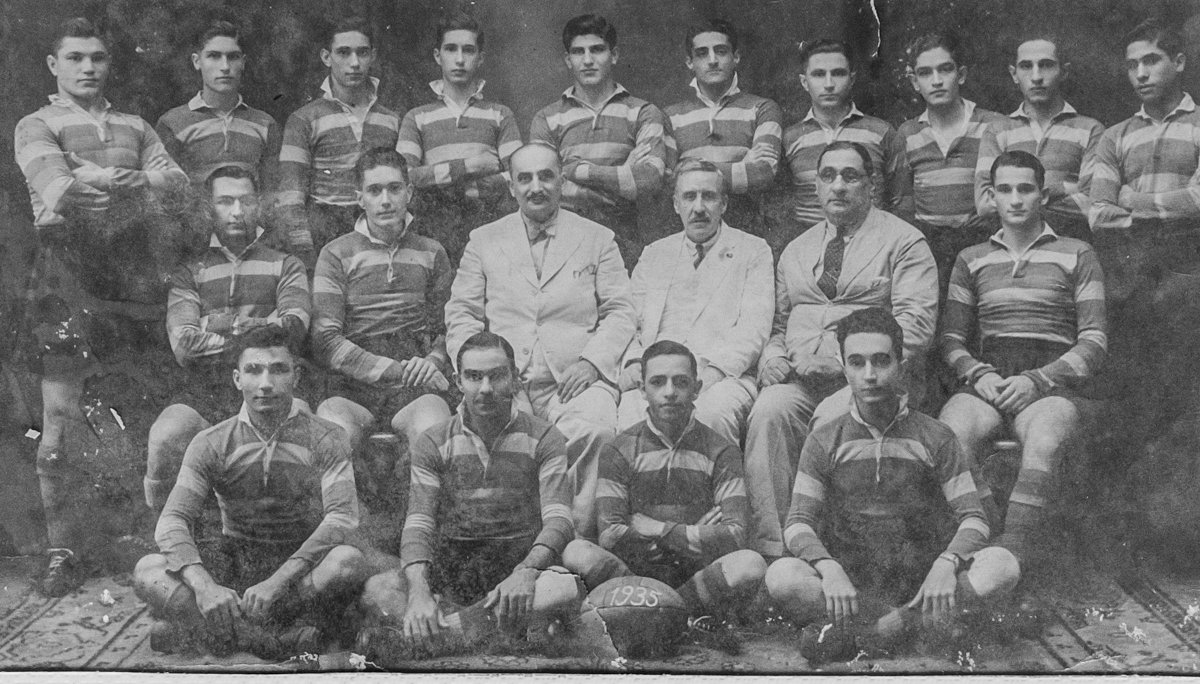
The afternoons were for visits to the Catchick Paul Chater Home for the Elderly when I was finally granted permission. The narrow, untidy streets dotted with food stalls, mechanics, the local mosque, stray dogs, children bathing seemed like a portal on the threshold of a deep dive into a forgotten past. The white and red paint of the chapel was still fresh. Low hanging juicy pomelos lured the senses. The quiet, much appreciated, was unexpected after the mayhem one experienced outside.

On my first visit, Chacha, then in his 80s, had just woken up from his afternoon nap. He was happy that someone was interested in his stories. Over the next year we became friends, and I would look forward to our meetings. Somewhere over his 70 plus years in Calcutta, Charles Sarkies transformed into “chacha” or uncle in Hindi. It was a title he wore with poise. He had built a life in Calcutta, as had so many Armenians. His only regret, he told me, was that he never met his mother after he came to Calcutta from Julfa to study at the ACPA. He was 12 years old at the time.
A few years later on my return to Calcutta (by now I had moved to New York, moved back to Calcutta and then moved to Goa), I learnt Chacha was no more. I went to his funeral, where I met his distraught daughter Margaret. She, like so many Calcutta Armenians, left the city for greener pastures. Margaret now lives in Sydney, as does her brother. Any trace of their family history in Calcutta is gone.
The exact dates are unknown, but many decades before the advent of the British and the East India Company, administrator Job Charnock, to whom the mantle has typically gone as the ‘founder’ of modern Calcutta, the Armenians were here at the behest of Mughal Emperor Akbar.
In 2003, a historic judgement was delivered by the Calcutta High Court.
“After months of deliberation, in what was considered to be a historic judgment, the Calcutta High Court had said that Charnock was not the founder of the city of Calcutta and directed the West Bengal government to stop associating Charnock’s name in this context, including removing textual references to it and to not celebrate August 24 as the city’s birthday. Very simply, the High Court had said, ‘Calcutta does not have a birthday.’” (Source: The Indian Express)
During my research, interestingly I came across a 1936 Bengal Past and Present journal—an article by Khojah Isreal Sarhad. It mentioned the tomb of Rezabeebeh, the wife of the late charitable Sookias:
“‘This is the tomb of Rezabeebeh
the wife of the late charitable Sookias
who departed from this world to life eternal
on the 26th day of Nakha in the year 15.
ie., on the 21st July 1630.’
What a world of questions is suggested by this newly found record?
Why was the source of this information never utilized before,
who was the ‘charitable Sookias’ and how did his family
come to be living in Calcutta sixty years before the advent
of the English? Was there already an Armenian settlement here?
Are the Armenians after all the Founders of the city?”
Khojah Israel Sarhad
Bengal Past and Present, (July-December) 1936
Journal of the Calcutta Historical Society
From Armenians of Calcutta
Why should they not be considered the founders of modern Calcutta?
Apart from the tombstone, so much of Old Calcutta was built by them. The contribution is unparalleled.
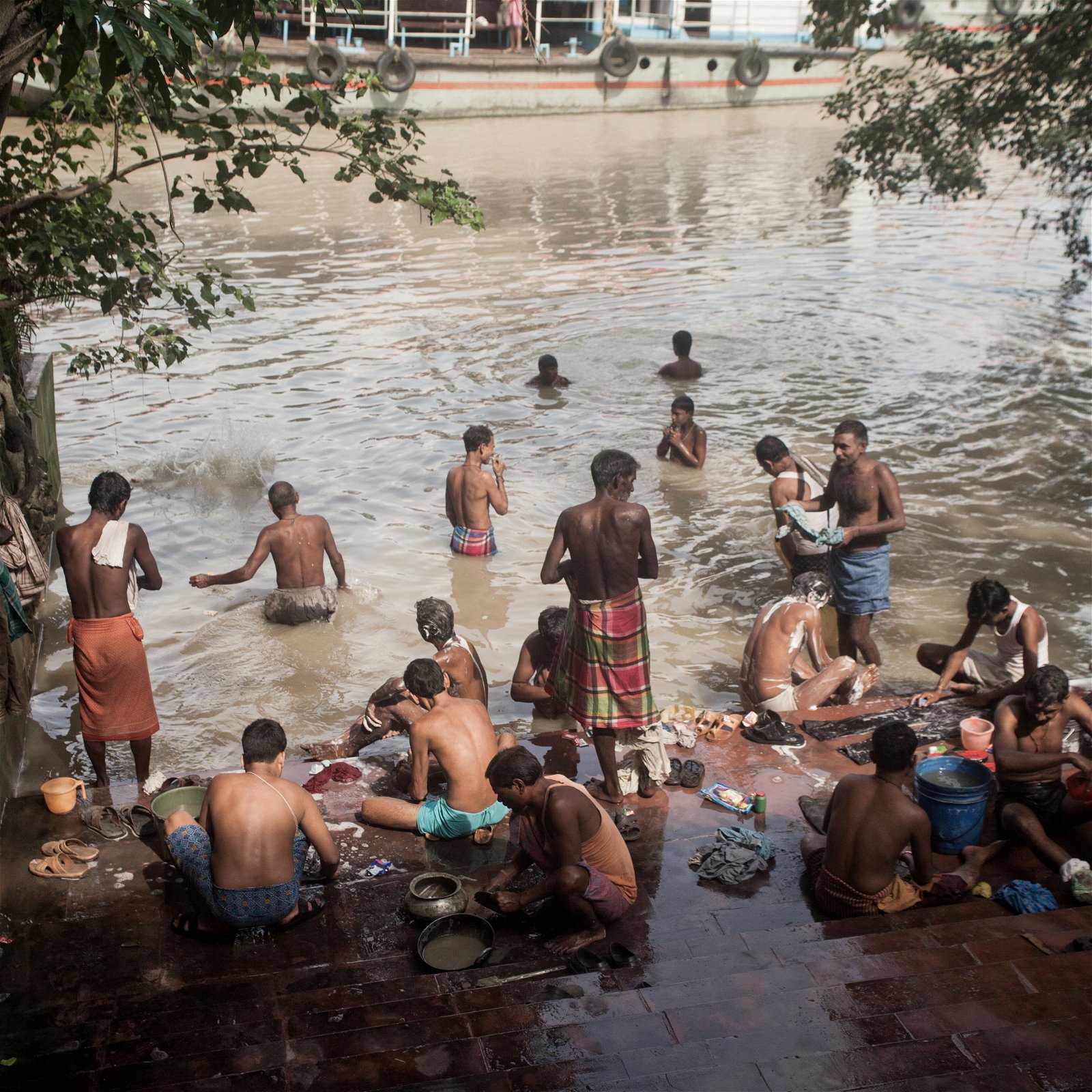
Over the years the work transformed from just photographs to a tableau of photos, text and archive. The archive became critical. Since most Armenians left, with just a handful left behind, it was impossible to come by research material. Did the material leave when they left? I chose to work around this absence – that which is left behind.
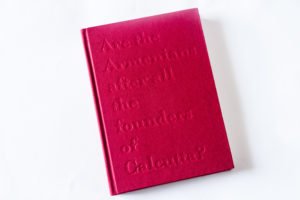
To find an alternate approach, I went looking for shellac, indigo, pure Armenian blood, Armenian delicacies and traditions. It was a shot in the dark because the absence is real, and with time, only getting deeper. In the 10 years I worked on this, many of them have passed on. The book is important and valuable to mark and celebrate this almost forgotten piece of history that is fast disappearing, designed like a valuable object.
Ultimately, the book Armenians of Calcutta is me introducing the community as I see them, through my interactions. But it’s their story, their history, intertwined with the history of Calcutta.
A few years ago, I did a show of the dummy book at the Armenian Club on Park Street.
Marie Stephen (Stephanian) was the first to arrive. She walked over into the darkness of the projection room.
She hadn’t expected to see herself on a large screen and sat there for a long time watching herself in a loop.
The sound of the Lord’s prayer in Armenian traveled across the room.
Slowly people started to trickle in.
Marie’s drill was followed by all. They walked involuntarily into the projection room with the sound of the music; on their way out, they found Marie with her red hair and red sweater narrating stories of her Armenian heritage.
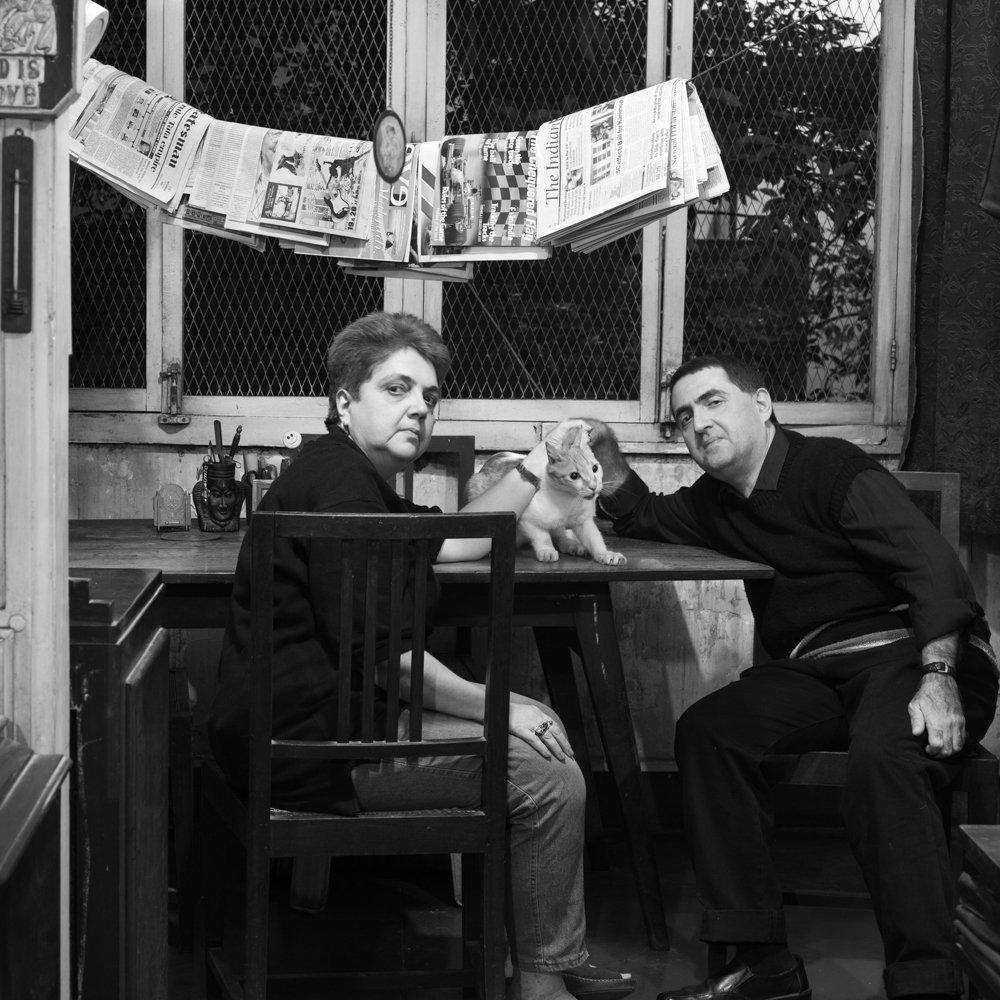
Years before this exhibition happened, I remember sitting on Marie’s dining table as she laid out all her family albums, Indian passports of her parents, the will of her grandmother. I wondered how this history would be preserved. Marie and her brother Saco are one of the last ‘pure’ Armenian families of Calcutta. Marie is the only one who archived her family history in carefully restored albums. Her hands gently went over the photographs, and she inaudibly said ‘now they’re all gone.’
To think of it, they came for business, set up a solid base, built the city, and then left. The city, in turn, appropriated the memory of everything like a wave in a monsoon sea, leaving only fissures of what remains. Once I looked through the cracks, I found some traces embedded under the weight of this frenetic city, only to discover a lot more than fleetingly seeing the Armenian boy at the high school party.
But so much is unknown and will perhaps always be.
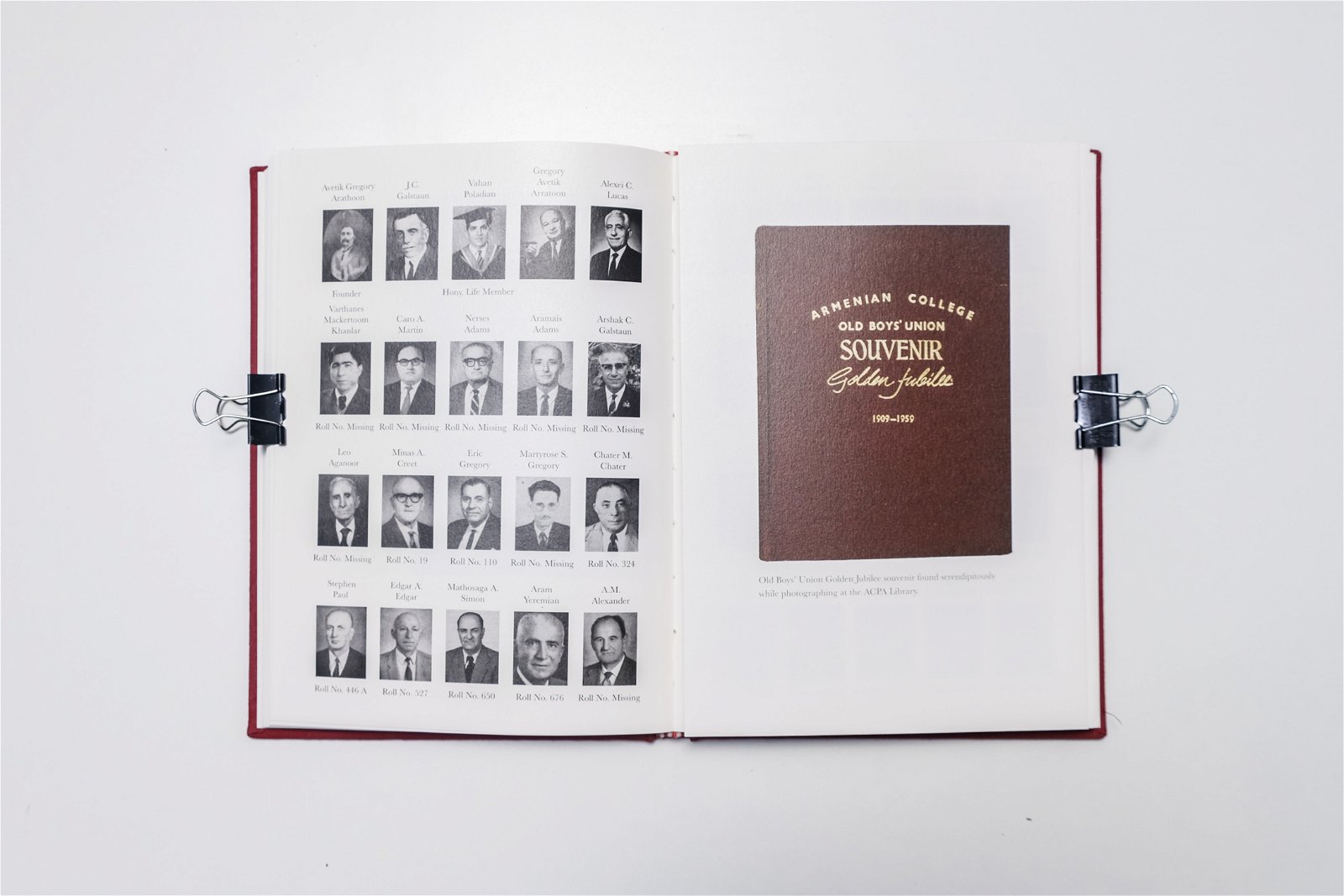


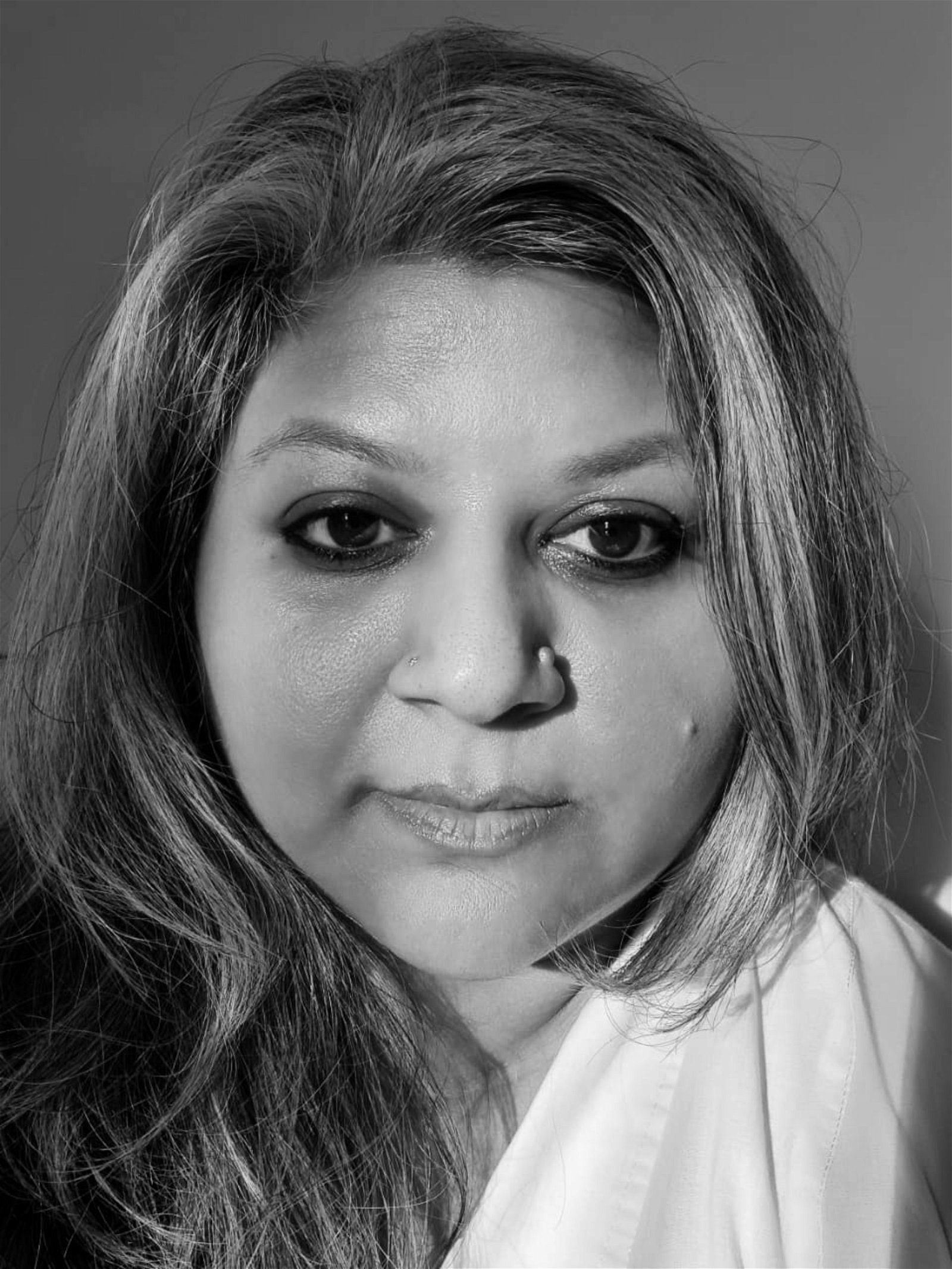
My Dad handed me a book on the Armenians of Calcutta book when I was younger, a book I swear he had memorized. I met my first Armenians from Calcutta when I went to Kalousdian’s in NYC at 28th and Lex. I was expecting an Armenian grocery store, and it kind of was, but I was surprised to find an Indian grocery story. The man running the store told me that his family was from Calcutta and spoke fluent Armenian. A pleasant surprise. Thanks for your work here.
Thank you. and thanks for the anecdote.
Thank Alakananda Nag and the Armenian Weekly for having brought to light the story of the Armenians in Calcutta. I have been a graduate of the Armenian College and Philanthropic Academy (ACPA) and here is a poem I wrote back in 1961 dedicated to the founders of ACPA.
TO MY ALMA MATER, ARMENIAN COLLEGE OF CALCUTTA
Written by Daniel Janoyan
Baghdad, Iraq, May 10, 1961
On a plain stone
Under the clock
In letters of gold
Thus they had wrote.
Menatsakan*, Aswadsadoor*
Were the founders of this school,
Their memories will never die
And be immortal as the age of time.
Vartan*, so was Muradkhanian*,
Buried many decades ago,
But like two streams of different births
They united and as a river flowed.
And like a river they carried on
With noble thoughts in mind
That still murmur for years to come
And live as they had done.
* Christian and surnames of the founders of Armenian College Philanthropic Academy, Calcutta, India in 1821
Daniel,
It was great to see your account of the script on the stone plaque that all of us boy memorised while serving our punishment of “standing under the clock”.
I still have a photo of you sitting on a chair and reading a book in the open assembly area of the school. I now live in London and would love to hear from you.
Thank you Daniel
This is delightful! And precious.
Amazing work congratulations well done
Fascinating! My ancestors also hail from Jikfa-Isfahan in Iran. I wonder if I have long-lost relatives that moved east to India to settle in Calcutta. Great work Miss Nag!
Thank you very much for this amazing work.
Congratulations Ms.Nag I am grateful for your hard work.
Thank you! Really appreciate it
Wow!
It warms my heart, sad yet beautiful from far far away times…
Years ago I remember in Oman, an Indian gentleman approached me very excited when he heard I was Armenian! He said, his father used to take him to the Armenian church every Sunday which he thought to be very impressive! He even spoke few Armenian words!
It brings tears of joy to my eyes when I hear our Armenian stories although ‘Taparagan’ hay!Great work, thank you.
What a fantastic story. I am an ex AC (Armenian College) boy 1948 to 1956.
I will be getting this book ASAP and look forward to reading it from cover to cover.
HI Micheal
So good to know you were in Calcutta and at ACPA!
The book is available here https://alakanandanag.com
Best wishes
This is amazing and the fact that you got to explore the earlier historical accounts of the Calcutta founding Armenians. Most recently with the 1994 Artsakh war, Armenian orphans had taken refuge at the Armenian Orphanage in Calcutta. The continuing legacy of the peace-loving hard working forefathers’ amazing footprints.
Thank for this Article Alaknanda. I grew up in Calcutta with my mother who was Armenian. I myself was baptised in the Armenian church in Australia while most of the family was baptised at the Holy church of Nazareth in Burra Bazaar. The roots trace back to my Great Grand father (Late Hyrapiet B. Sookias) who moved from Armenia to Julfa during the difficult times and then came to Calcutta with his brothers to Work and make a life.
I currently live in Dubai and in fact am in Yerevan on holiday as I write this. Proud to be the first in the family to visit and also to be a part of this great heritage. It’s unfortunate that the number of Armenians in Calcutta have reduced over the last 20+ years but it’s always great to know that there’s still a strong presence in some way.
In another note for anyone who may read this – try to visit this wonderful country at some stage. It’s truly spectacular.
Hello Mr, Karamjit Eric Singh
i was wondering if you i could ask you a bit over your Great grand father.
i to have Sookias ancestors.
i was wondering if there is a conection with your family.
Tamscreatie@gmail.com